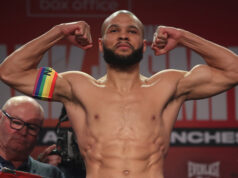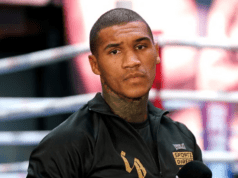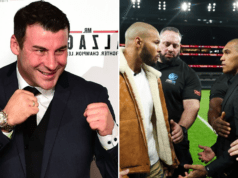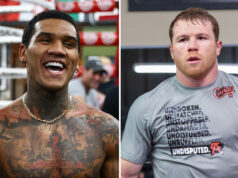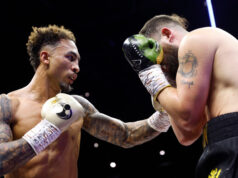In an article appearing today in the Sports Business Journal, writer Bill King takes a look at the upcoming Pacquiao vs. Mosley fight to see whether or not it will have a dramatic effect on the landscape of boxing on television, and throughout the industry. Take a look at the details to why the fight moved to Showtime and CBS to begin with, and what it could mean for the future of the sport if it’s successful.
- Will CBS’s experiment change boxing on TV?
- By Bill King, Senior Writer, Sports Business Journal
- Published May 2, 2011, Page 1
As he shopped the pay-per-view rights to Manny Pacquiao’s upcoming fight against Shane Mosley, the president of boxing promotions company Top Rank sent a set of basic financial terms to the three networks that play prominently in boxing: HBO, Showtime and ESPN.
He also asked the question that would frame Top Rank’s choice: What, from your vast spread of media holdings, would each of you provide to raise the profile of these fighters and this fight?
He wanted to know what HBO would deliver from Time Warner, and particularly from the Turner networks; what Showtime could find from across the realm of CBS; what ESPN could bring from Disney and ABC. Promotion of pay-per-view long has been driven by exposure offered by cable outlets and satellite providers, and by the premium channels that, while appreciated for their checkbooks and their air time, reach no more than a quarter of U.S. TV homes.
Todd DuBoef and his boss, Top Rank Chairman Bob Arum, wanted more.
“The currency was the audience, not the dollars,” said DuBoef, the president of Top Rank. “How do I make my product more available?”
“You layer in things and then you see: This is what we have; this is what we could have.”
DuBoef said he heard nothing of note from ESPN and little from HBO that he hadn’t heard before. But from Showtime, often seen as the underdog tugging at HBO’s hem, came word that CBS was willing to talk. The deal that emerged is unlike anything boxing has seen.
For the Showtime-produced “Fight Camp 360” show that profiles both fighters, CBS offered a slot as a prime-time special, which aired this past Saturday night, along with a half hour on the afternoon of the Final Four and an hour this Saturday afternoon, ahead of fight night. It offered promotion on other weekend sports programming. It offered exposure well beyond the bounds of sports: Segments on “Entertainment Tonight,” which CBS distributes, and on “The Early Show” and others. It pledged to push out features to both owned and operated stations and affiliates. It tapped into CBS Radio and CBS Outdoor.
“It’s all that CBS can bring to bear, including 115 million homes — I gotta give it a chance,” DuBoef said of his decision. “How could we not do it?”
“Top Rank was used to doing it the way they did it at HBO,” said Ken Hershman, executive vice president and general manager of Showtime Sports. “My pitch to them was you’re taking more of a risk trying to go through that same infrastructure time after time. It’s not growing the buys. They’re up and down and up and down. I felt like business as usual was more of a risk to them than coming our way and exploring this new opportunity.”
‘Enormous consequences’
Thirty years ago, Seth Abraham changed the landscape of boxing as head of sports at fledgling HBO. Charged with landing high-profile sports programming to attract subscribers, Abraham offered fight promoters the allure of Saturday night prime time, backed by rights fees far larger than those offered by the traditional networks.
All the glitzy fighters were gone from CBS, ABC and NBC by the 1990s, residing instead on HBO and Showtime. Before long, all their biggest fights would air live exclusively on pay-per-view. The premium channels expanded their subscriber base and the fighters and promoters fattened their wallets. But the profile of the sport dwindled, a fact that all the stakeholders bemoaned but none effectively addressed.
And then, late last year, along came Top Rank with a proposal and in came CBS.
“I think this is the most important fight, out of the ring, in 20 years,” said Abraham, who served as president of HBO Sports until 2000, then worked as chief operating officer and president of Madison Square Garden through 2003. “There could be enormous consequences.
“If the pay-per-view rate is meteorically higher, you have to assume it had a lot to do with the promotion on CBS. So if CBS really impacts the buy rate for Top Rank, if the delayed broadcast on Showtime is a big success, I think what you’re going to see is that NBC/Versus will pay more attention, ABC/ESPN will pay more attention, and Fox and FX and their regional networks will pay more attention. If CBS and Showtime are successful for Top Rank, then I see a completely different boxing landscape that HBO will be facing.
“It’ll be a real slugfest for every important fight.”
When describing the potential audience for a fight, Abraham parcels it into three: The rabid, the adamantly disinterested and the broader sports fans, who drop in and out of boxing depending on whether they view a fight as a major event.
“You have the ones you’re always going to get, the ones you’re never going to get, and then the group in the middle, which is the group that really matters,” Abraham said. “The sports fan will watch Ali, will watch Tyson, will watch Manny Pacquiao. For most fighters, they don’t care and they won’t watch. But they watch big events. So how do you best use the resources of Time Warner, or in this case CBS, to convey that this is a big event?”
HBO’s creation of a “24/7” franchise that takes viewers behind the scenes with fighters and their camps in the weeks leading up to a big PPV was a game-changer for the network. It frequently credits those shows with creating or reviving fight fans and resuscitating sales of the fights, the larger of which now generate upward of 1 million buys and eclipse $50 million in revenue.
HBO’s shows are, for the most part, available in fewer than 30 million homes. One school of thought says taking the Showtime “360” show to CBS, which is available in 115 million homes, should increase buy rates. Skeptics point out that the impact of that exposure could be deadened by the stiff $55 to $65 PPV price.
There is no debate over the unprecedented quantity of promotion that CBS has delivered. The Final Four is a sporting showcase. Even though Saturday traditionally is the least-watched night of the week, it’s still a network prime-time slot for a “Fight Camp 360” dedicated entirely to the fight.
“That’s really a lot of prime real estate, beachfront real estate,” said Kelly Kahl, senior executive vice president of CBS Primetime, who has programmed the network’s nightly lineup since 2001. “Now we have to translate this enormous reach into buys. Step one is letting them know the fight is there. Step two is getting them to click the button. Time will tell, but we’re certainly hopeful.
“I think everyone is looking to see whether we can move the needle.”
‘The death knell for boxing’
When CBS Sports lost the NFL in 1994, Rick Gentile was executive producer. He thought boxing’s popularity among men would make it a natural replacement for pro football. Gentile met with Abraham, asking whether HBO might want to combine with CBS on fights. HBO would get broader exposure for some of its boxers and CBS would get programming to fill its void. Abraham told Gentile he was interested.
“I went back to CBS excited, and our sales executives shot me down in about a minute,” said Gentile, who now serves as director of the Seton Hall University Sports Poll. “I saw that, and I saw what HBO was paying for fights, and I knew it was over. … It was the death knell for boxing on the networks.”
It was the departure of sponsor Budweiser in the mid-’90s that eventually booted boxing from the air at CBS. Reminded of the brand’s exit, the man who long ran sports marketing for Anheuser-Busch, Tony Ponturo, flashed back to the way Bud got into boxing. It was as a favor to R.J. Reynolds, which had signed a one-fight deal with Don King but feared it might run afoul of federal tobacco ad regulations. A-B agreed to take its place.
“I woke up one morning and we had a full-page spread in SI of the fight, with the Bud logo as big as a house,” Ponturo said. “If you can get an advertiser in and they have a good experience, you can get them hooked.”
Gentile saw Arum recently and reminded him that, regardless of the interest he might build in Pacquiao, the networks would not move back into boxing unless they could attract sponsors. “I got sponsors,” Arum told him.
“I think Bob is right in every way when he says this could be the kick-start,” Gentile said. “Having said that, I can see the corollary. Nothing could happen. We’ll see.”


